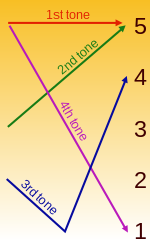Chinese (Mandarin)/Using Tones
Using Tones
[edit | edit source]
Every syllable in Chinese has a clearly defined pitch of voice associated with it to distinguish characters with the same sound from each other. Unfortunately, there is no indication of the tone given when reading a character, so the tones for words must be individually memorized. To help with this, pinyin uses four easily-remembered diacritical marks to tell you what the tones of words are. The diagram to the right shows the pitch changes of the four tones on a five-bar scale going from lowest (1), to highest (5), while the five tone marks are:
- First tone (阴平)( ˉ ), high level.
- Second tone (阳平)(ˊ), middle rising.
- Third tone (上声)( ˇ ), low dipping.
- Fourth tone (去声)(ˋ), high falling.
- Tone of unstressed syllable (轻声)(without any marks), low level.
Tone marks are always placed over vowels, never consonants. If there is more than one vowel in the syllable, the mark placement is determined by three simple rules.
- If there is an a, the tone goes on the a.
- In the ei and ou combinations, the first vowel takes the tone mark.
- In all other finals, the last vowel gets the tone mark.
You can also do this:
- In the IU final, the tone mark is on the U.
- In the IONG final, O gets the tone mark.
- In all other finals, the tone mark is on the vowel listed first in AEIOUÜ.
Pronouncing the tones
[edit | edit source]
Say the first tone as if you were singing a high note. The second tone is pronounced like a question in English, with your pitch rising at the end of the syllable. Third tones are low and extended, noticeably longer than the other tones because of the dip. The fourth tone is said abruptly and forcefully, like a curt command in English. The neutral tone's pitch depends on the tone that precedes it. It is described more fully below, but in general, they are pronounced quickly and softly. The classic example used to show the difference tones make is:
|
|
|

In many cases, several characters can have exactly the same syllable and tone. For example, along with 马, the characters 码 and 蚂 are also pronounced exactly the same (mǎ). 马 can be used alone to mean the animal "horse." It can also be combined with other characters for new meanings. 马上mǎshàng-immediately; 马球mǎqiú-polo; 马路mǎlù-street; etc. Other characters with the same pronunciation will be used differently as well. 数码相机shùmǎ xiàngjī-digital camera; 蚂蚁mǎyǐ-ant; etc. Since these characters alone sound exactly the same in conversation, the only way to distinguish them is through context.
Tone changes
[edit | edit source]The third tone, with its dip-and-rebound, is hard to fit into a continuous sentence. This is why the third-tone changes depending on its environment. There are two rules:
- If a third tone comes before another third tone, then it is pronounced as a second tone.
- If a third tone comes before any other tone, then it only dips, and doesn't rebound and is called a half-third tone (see image).
Because of these broad rules, the majority of third tones you encounter will be spoken as second tones or half-third tones. Be mindful of this because the written tone marks remain unchanged despite the differences in actual pronunciation.
Neutral Tones
[edit | edit source]Some syllables don't have a tone and carry no tone mark. They are not stressed, and they take their tone from the syllable before them:
- If it follows a first- or second-tone syllable, then the toneless syllable is mid-range.
- If it follows a third-tone syllable, then the toneless syllable is high, as if the dip-and-rebound of the third-tone continues right into it.
- If it follows a fourth-tone syllable, then the toneless syllable is low, as if the fall of the fourth-tone continues right into it.
Test and Review
[edit | edit source]
